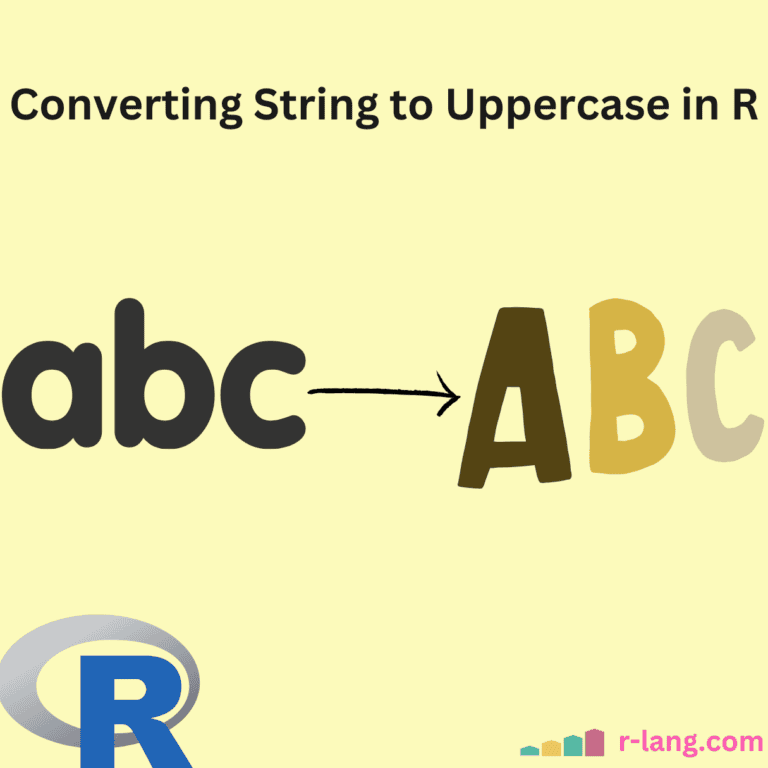For string operations like comparing strings, data standardization, formatting output, or input validation, we may want to convert the input to uppercase (or lowercase, depending on the situation) to ensure consistency and prevent errors caused by inconsistent capitalization.
The toupper() function converts a string to an upper case. It accepts an input string and converts all alphabetic characters in a string to their uppercase equivalents.
The toupper() function will not change non-alphabetic characters (like numbers or punctuation).
Syntax
toupper(str)Parameters
| Name | Value |
| str | It is a string to be converted to uppercase. |
Basic conversion
In the above figure, you can see that we converted an input string rlang to uppercase RLANG.
str <- "rlang"
str_upper <- toupper(str)
str_upperOutput
[1] "RLANG"Passing a string with a numeric value
Let’s define a string that contains alphabets and numeric values.
mixed_str <- "c2v2kb"
uppercase_mixed <- toupper(mixed_str)
print(paste("Original:", mixed_str, "Uppercase:", uppercase_mixed))
# "Original: c2v2kb Uppercase: C2V2KB"The commented output in the code above shows that uppercase() left numeric values unchanged while converting lowercase letters to uppercase.
Converting a vector of strings
You can also pass a vector of strings, which you need to convert into uppercase. Since the toupper() function is vectorized, it can be applied to multiple strings at once.
# Vector of strings
string_vector <- c("Hello", "R-lang", "blog")
# Convert each string in the vector to uppercase
uppercase_vector <- toupper(string_vector)
# Print the result
print(uppercase_vector)
# [1] "HELLO" "R-LANG" "BLOG"Handling mixed data types (with coercion)
Let’s define a vector of mixed data type values, including character vectors, and use our function.
mixed_data <- c("text", 123, TRUE, "another string")
uppercase_mixed <- toupper(mixed_data)
print(paste("Original:", mixed_data, "Uppercase:", uppercase_mixed))
# [1] "Original: text Uppercase: TEXT"
# [2] "Original: 123 Uppercase: 123"
# [3] "Original: TRUE Uppercase: TRUE"
# [4] "Original: another string Uppercase: ANOTHER STRING"The output shows that boolean and numeric values remain as they are, while alphabetic letters are converted to uppercase.
Case-insensitive comparison
If you want to compare two strings but they have different cases, you can convert all of them into uppercase and then compare both strings.
string1 <- "kaynes technology"
string2 <- "Kaynes Technology"
# Incorrect comparison (case-sensitive)
print(paste("Case-sensitive comparison:", string1 == string2))
# Correct comparison (case-insensitive)
print(paste("Case-insensitive comparison:", toupper(string1) == toupper(string2))) # nolint
# [1] "Case-sensitive comparison: FALSE"
# [1] "Case-insensitive comparison: TRUE"
Handling NA values
If an element in the input vector is NA, the toupper() function correctly identifies it as NA, and the corresponding element in the output vector will also be NA. It maintains data integrity when working with missing values.
data_na <- c("text", NA, "another string")
uppercase_mixed <- toupper(data_na)
print(paste("Original:", data_na, "Uppercase:", uppercase_mixed))
# [1] "Original: text Uppercase: TEXT"
# [2] "Original: NA Uppercase: NA"
# [3] "Original: another string Uppercase: ANOTHER STRING"That’s all!

Krunal Lathiya is a seasoned Computer Science expert with over eight years in the tech industry. He boasts deep knowledge in Data Science and Machine Learning. Versed in Python, JavaScript, PHP, R, and Golang. Skilled in frameworks like Angular and React and platforms such as Node.js. His expertise spans both front-end and back-end development. His proficiency in the Python language stands as a testament to his versatility and commitment to the craft.



